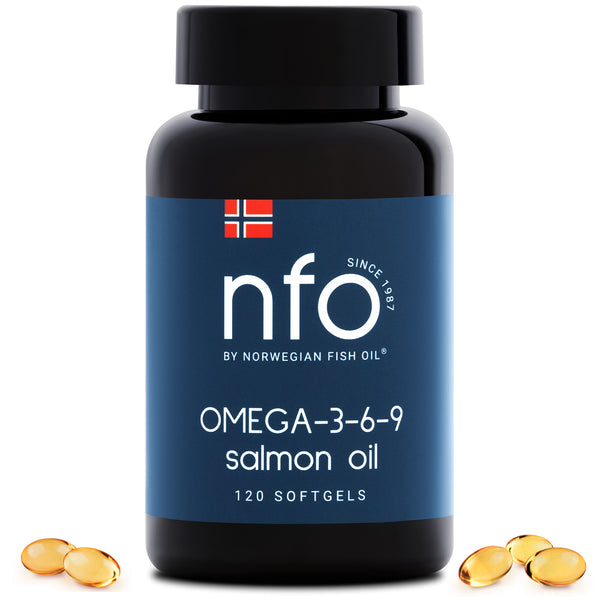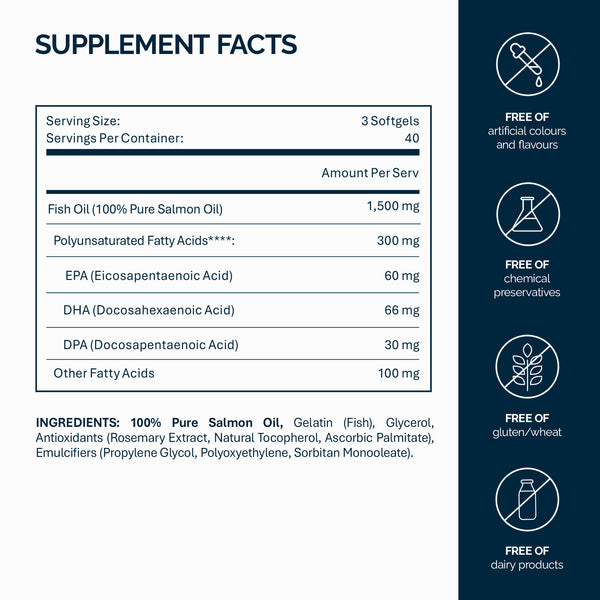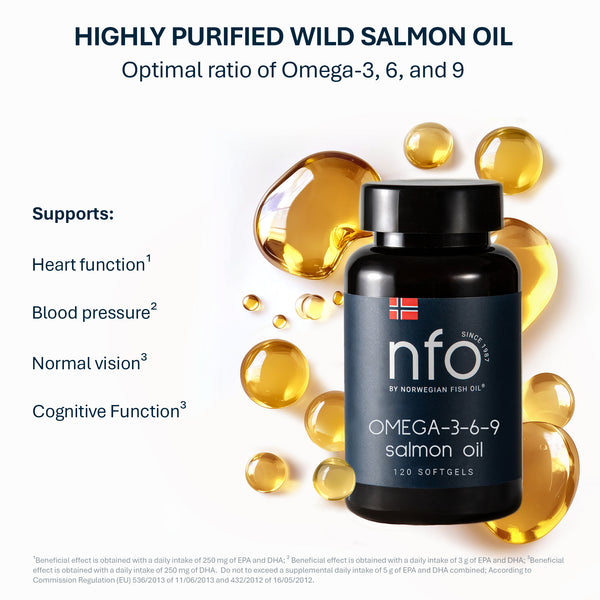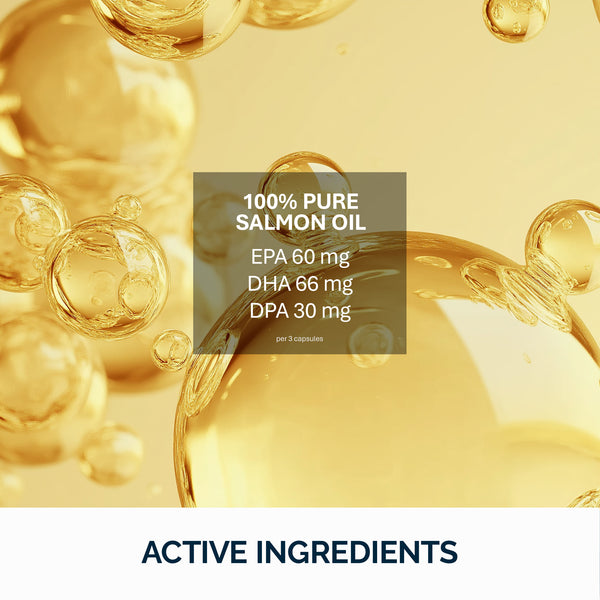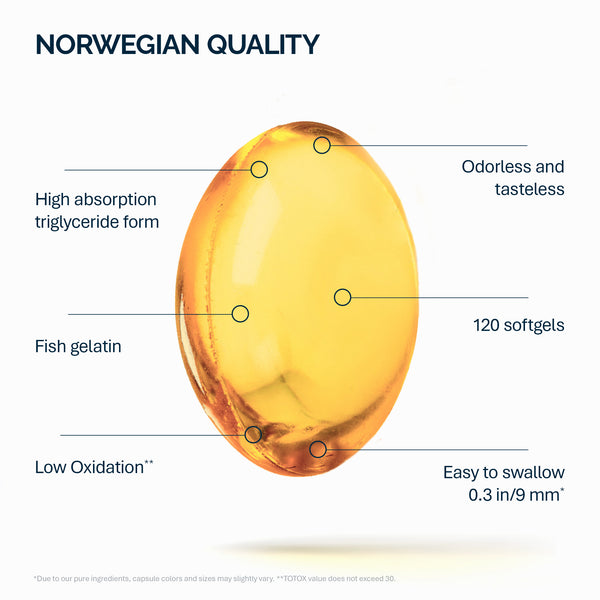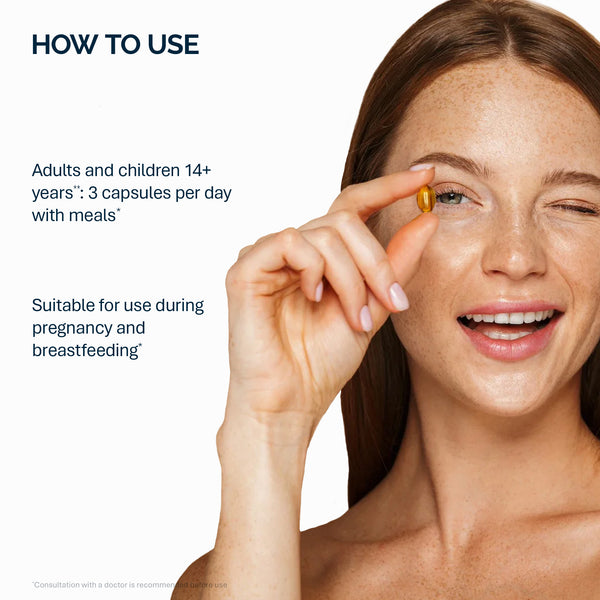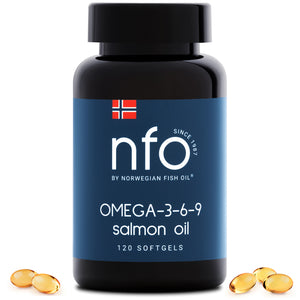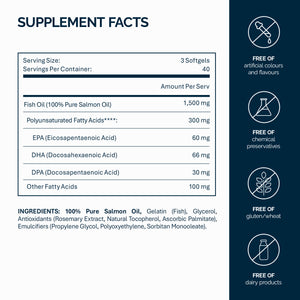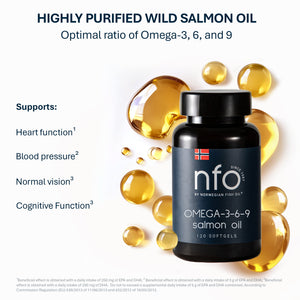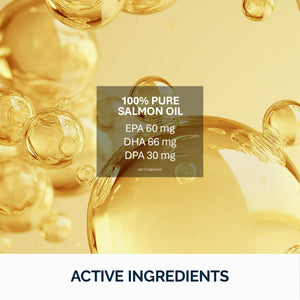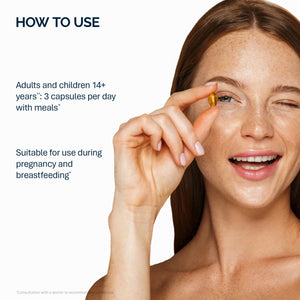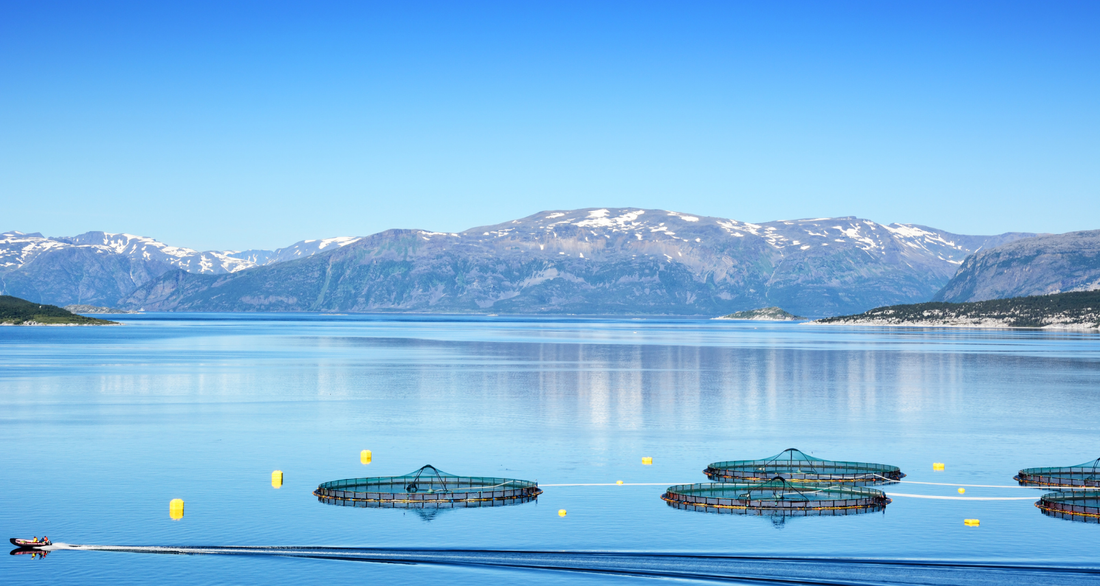
Omega‑3 fatty acids are among the most crucial nutrients for modern wellness, and they can come from a variety of sources. Lately, “Norwegian salmon oil” has been gaining attention as a premium Omega‑3 supplement. What sets Omega‑3 from Norwegian salmon apart from the rest? In this post, we will explore its unique nutritional profile and purity, compare it with other common Omega‑3 sources like anchovy, sardine, and algal oil, highlight quality certifications and a notable product example, and offer tips to identify genuine Norwegian salmon oil on the market.
Nutritional profile of Norwegian salmon omega‑3
Norwegian salmon oil stands out for its rich and balanced Omega‑3 content. Salmon naturally provides a mix of EPA, DHA, and even some DPA – three key Omega‑3 fatty acids that support heart, brain, and overall health. Notably, salmon oil tends to have a higher DHA-to-EPA ratio than many other fish oils. In fact, DHA levels in salmon oil are often about twice the EPA levels. This means Norwegian salmon oil is especially potent for cognitive and visual benefits (thanks to DHA) while still providing ample EPA for inflammation support and heart health.
Importantly, the Omega‑3s in Norwegian salmon oil are in their natural triglyceride form, which is the form found in fish tissues. This natural form is easily recognized and absorbed by the body. Each serving of a high-quality salmon oil can deliver a substantial dose of Omega‑3. For example, salmon oil was reported to provide roughly 4.25 grams of EPA+DHA per tablespoon, which is higher than the 1.4–2.9 grams per tablespoon typical of many generic fish oils. While individual supplements vary, a product made from 100% Norwegian salmon oil will list the specific EPA, DHA, and DPA content per capsule. One such product, NFO Omega‑3-6-9 Salmon Oil, specifies per capsule 40 mg EPA, 44 mg DHA, and 20 mg DPA from 1000 mg of pure Norwegian salmon oil. This highlights that Norwegian salmon oil naturally includes DPA, a less common Omega‑3 that may enhance the benefits of EPA and DHA. Overall, the nutritional profile of Norwegian salmon Omega‑3 is distinguished by its DHA-rich composition and inclusion of the full spectrum of Omega‑3s (EPA, DHA, DPA), delivered in a natural form.
Purity and quality standards of Norwegian salmon oil
Beyond its fatty acid profile, Omega‑3 oil from Norwegian salmon is often lauded for its purity and quality. Norway’s reputation in the Omega‑3 world comes from strict standards and the pristine environments associated with its fisheries. The cold, clean waters of Norway result in fish that are less likely to accumulate heavy metals or pollutants. Norwegian marine sources benefit from low pollution levels, meaning salmon from these waters tend to have lower traces of mercury, PCBs, and other contaminants. This gives Norwegian salmon oil a head start in purity even before processing.
Moreover, Norwegian Omega‑3 producers are known for advanced processing and rigorous testing. Many Norwegian fish oil facilities use techniques like molecular distillation to further remove any impurities while preserving nutritional value. Each batch of oil is typically tested by third-party laboratories to ensure it meets or exceeds international standards for contaminants and freshness. For instance, Norwegian manufacturers often certify that their oils have undetectable levels of heavy metals and toxins, far below the limits set by health authorities. In the case of NFO products, every batch is independently tested for purity, oxidation levels, heavy metals, and pathogens, with a Certificate of Analysis available for consumers. Such stringent quality assurance means that when you choose a Norwegian salmon Omega‑3 supplement, you are likely getting an oil that is clean (free of “nasties”), fresh (low oxidation, no rancid smell), and true to label. The focus on quality in Norway’s Omega‑3 industry – from clean raw materials to high-tech refining – is a big part of what makes Norwegian salmon Omega‑3 different and often superior in quality.
Norwegian salmon oil vs. other omega‑3 sources
Not all Omega‑3 supplements are created equal. Here is how Norwegian salmon oil compares to some other common Omega‑3 sources:
- Anchovy/sardine fish oil: Most mass-market fish oil supplements are derived from small oily fish like anchovies and sardines. These species are very rich in Omega‑3 (anchovy oil is about 30% EPA+DHA by weight) and are commonly used because they are abundant. Anchovy and sardine oils typically have a more balanced EPA to DHA ratio (often roughly 1:1) and contain only minor levels of DPA. By contrast, Norwegian salmon oil usually has a higher proportion of DHA relative to EPA, as mentioned earlier. Salmon oil may have slightly lower total Omega‑3 concentration compared to highly processed anchovy oils, especially if those are concentrated; however, salmon oil offers a more natural profile with components like astaxanthin and DPA that standard “fish oil 1000 mg” capsules (often anchovy-based) might lack. Another difference is sourcing and quality: Norwegian salmon oil is often sourced from carefully regulated fisheries or aquaculture with strict quality checks, whereas generic fish oil might come from large global fisheries with varying quality. Many people also subjectively find that salmon oil capsules have less of a fishy aftertaste compared to some generic fish oils – possibly due to freshness and the inclusion of antioxidants like astaxanthin.
- Algal oil (vegetarian omega‑3): Algal oil is a plant-based marine Omega‑3 source, produced from microalgae. It is a popular choice for vegetarians and vegans since it provides DHA (and in some products, a little EPA) without involving fish. In terms of composition, algal oil is typically very high in DHA but contains little to no EPA – often it has 50% more DHA than an equivalent amount of fish oil, but minimal EPA unless fortified. This makes algal oil excellent for supporting brain and eye health (DHA) but not as efficient for anti-inflammatory needs that benefit from EPA. Norwegian salmon oil, on the other hand, naturally contains a balance of EPA and DHA (with DHA dominant but EPA still present). Also, salmon oil includes DPA and other fatty acids that algal oil lacks. When it comes to purity, algal oil is produced in controlled conditions, so contaminants are negligible – but high-quality Norwegian salmon oil similarly is purified and tested to be safe. Cost and availability are other factors: algal Omega‑3 supplements tend to be more expensive and sometimes lower in total Omega‑3 per capsule, whereas fish-derived oils like salmon oil often give you more Omega‑3 per dose at a lower cost. For those who do not require a vegan solution, Norwegian salmon oil offers a comprehensive Omega‑3 profile that algal oil might not fully provide (unless one only seeks DHA).
In summary, Norwegian salmon Omega‑3 distinguishes itself by offering a broad spectrum of Omega‑3s in natural form, a DHA-rich profile with bonus nutrients like astaxanthin, and coming from a source known for quality and cleanliness. Anchovy/sardine oils are Omega‑3 workhorses and very effective too, but they are more commoditized – while algal oil serves a niche for plant-based needs with a focus on DHA. Norwegian salmon oil occupies a premium spot as a potent, naturally balanced Omega‑3 source with a story of quality behind it.
Quality certifications and product examples
When choosing an Omega‑3 supplement, especially one marketed as Norwegian salmon oil, it is wise to look for signs of quality and authenticity. Reputable products often carry certifications or quality seals that indicate high standards. For example, some Norwegian fish oil products are certified by the Marine Stewardship Council (MSC) for sustainability if the oil is sourced from wild fisheries. Others might have Friends of the Sea certifications or Aquaculture Stewardship Council (ASC) labels if the salmon oil is derived from responsible farming practices. Quality-focused brands may also adhere to the standards of GOED (Global Organization for EPA and DHA Omega‑3) or have 5-star ratings from IFOS (International Fish Oil Standards) to demonstrate purity and freshness. These logos and certifications on a bottle are a quick way to gauge if the producer follows stringent protocols.
It is also helpful to consider examples of trusted products. One such example is NFO Omega‑3-6-9 Salmon Oil by Norwegian Fish Oil – a product made in Norway that exemplifies the quality discussed. This supplement uses 100% Norwegian salmon oil and is produced under Norway’s strict quality control. This can be appealing for those who want a more complete essential fatty acid supplement. When evaluating similar products, check if they mention the salmon species and origin (Norwegian Atlantic salmon, for instance), and whether they provide transparent data on EPA/DHA content and purity testing. High-quality Norwegian brands often proudly state their origin and may even include a unique batch number that consumers can use to request a lab analysis.
In short, look for clear labeling and certifications: terms like “Made in Norway,” purity seals, and sustainable sourcing badges are good indicators. The presence of a specific company name or brand that is based in Norway (such as Norwegian Fish Oil, Möller’s, etc.) can also signal that the product is part of Norway’s tradition of quality in Omega‑3 supplements.
How to identify genuine Norwegian salmon oil
As demand grows for Norwegian salmon Omega‑3, consumers should stay savvy to ensure they are getting an authentic product. Unfortunately, some less scrupulous suppliers may label a product as “salmon oil” (or even “Norwegian salmon”) while the contents might be diluted with cheaper fish oils. In fact, independent testing has found that a significant portion of omega supplements marketed as single-species oils (like pure salmon oil) did not contain what the label claimed, especially in overseas markets. Higher-priced oils such as salmon or krill are the most likely to be adulterated by being mixed with standard fish oil or other oils. This makes it crucial to verify authenticity.
So, how can you identify a genuine Norwegian salmon oil product? Here are some tips:
- Check the label for origin: A genuine Norwegian product will often explicitly state its Norwegian origin. Look for phrases like “Made in Norway” or “Product of Norway” on the bottle. Norway even has an official “Made in Norway” origin label program administered by Innovation Norway – companies meeting strict origin and quality criteria can use this label. Such a mark (often a stylized flag or logo) is a strong sign of authentic Norwegian sourcing.
- Examine the ingredients and details: The ingredients list and supplement facts panel can reveal a lot. If it says “Salmon oil (Salmo salar) – 100%” that is a good sign. If it just says “fish oil” or a vague blend, it may not be primarily salmon. Genuine salmon oil will usually list the specific Omega‑3 content (EPA, DHA, etc.) per serving. Compare those numbers to what you expect from salmon – for instance, a very high EPA content might suggest it is actually anchovy or a concentrate, since salmon naturally has more DHA than EPA. Authentic salmon oil in natural form will typically have DHA > EPA and also mention DPA. Additionally, the presence of astaxanthin (sometimes noted by a slight orange tint in the oil or mentioned on the label) can hint that it is real salmon oil, as astaxanthin comes from salmon’s diet.
- Look for 3rd-party testing or verification: Trustworthy brands will often mention third-party testing, like “independently tested for purity” or certifications like IFOS. Some Norwegian companies are taking it a step further by using authenticity verification services. For example, OmegaVeritas/ORIVO is a Norwegian laboratory that can test fish oil to confirm if it truly comes from salmon and even from which region. If a brand advertises that their salmon oil is verified by an authenticity test (with an ORIVO seal or similar), you can have extra confidence that it is genuine. While not all brands use this, it is an emerging gold standard for authenticity.
- Evaluate the brand reputation: Do a bit of research on the brand. Is it a Norwegian company or a well-known Omega‑3 producer? Brands with a long history (for example, those that have been in Norway’s fish oil industry for decades) are less likely to sell fake products, as their reputation is built on quality. Check the company’s website for information on sourcing – reputable brands will be transparent about where their fish comes from and how the oil is processed. If a product is simply marketing the Norwegian angle but the company has no ties to Norway or no story to back it up, that’s a red flag.
- Price and packaging cues: While price is not an absolute indicator, be wary of extremely cheap “Norwegian salmon oil” supplements sold by unknown sellers. If the price seems too good to be true for a salmon oil (which is usually a bit more expensive to produce), it might not be pure salmon oil. Packaging can also give hints: authentic products often use high-quality packaging (dark glass bottles for liquids, robust labeling) and might include the Norwegian flag or languages. Counterfeit or subpar products might have spelling errors or generic fish images. Always buy from reputable retailers or directly from the manufacturer when possible.
By following these steps – confirming origin, reading the fine print on labels, seeking out quality seals, and sticking to trusted sources – you can ensure that you get the real benefits of Norwegian salmon Omega‑3. When you do find a genuine product, you will appreciate why it stands out: a robust nutritional profile delivered with exceptional purity and integrity. In a world of many Omega‑3 options, Norwegian salmon oil has carved out a niche as a premium choice, and knowing how to pick the real thing will help you take full advantage of its unique benefits.
References
- NFO Blog – “Which fish species boast the highest EPA, DHA, and DPA?” (2023). Describes salmon oil’s high DHA:EPA ratio, inclusion of astaxanthin, and presence of DPA nfo.com.
- NYO3 Blog – “Salmon Oil vs Fish Oil: A Complete Nutritional & Benefit Guide.” (2025). Notes that salmon oil can provide ~4.25g EPA+DHA per tablespoon versus 1.4–2.95g in other fish oils nyo3.com.
- PomeFresh Omega-3 Blog – “Why Norwegian Fish Oil is the Best: Purity, Sustainability & Quality.” (2024). Highlights Norway’s clean cold waters with low pollution, yielding purer fish oil with fewer contaminants pomefresh.com, and discusses advanced purification like molecular distillation pomefresh.com and MSC-certified sustainable practices pomefresh.com.
- Norwegian Fish Oil (NFO) – Product FAQ and Info for Omega 3-6-9 Salmon Oil. Emphasizes that oils are made in Norway under strict quality standards, with every batch tested for purity, heavy metals, and provided with a Certificate of Analysis nfo.com. Ingredient list confirms 100% Norwegian salmon oil with 40 mg EPA, 44 mg DHA, 20 mg DPA per capsule nfo.com.
- Verywell Health – “Algae Oil vs Fish Oil: Which Omega-3 Source Is Better?” (2025). Explains that algal oil typically contains significantly more DHA but little to no EPA compared to fish oil verywellhealth.com.
- NutraIngredients – “Omega-3 adulteration...fail to meet single species label claims.” (2021). Reports that 9 out of 19 tested omega-3 products (including some claiming 100% salmon oil) were not authentic, and that about 30–45% of premium oils like salmon or krill are adulterated with cheaper oils nutraingredients.com.
- Innovation Norway – Made in Norway official origin label. Details the criteria for using the “Made in Norway” mark for authentic Norwegian products businessnorway.com.
- ORIVO/OmegaVeritas News – “World’s first salmon oil product verified by authenticity test.” (2025). Describes a new NMR-based test that can confirm salmon oil authenticity, noting that some products on the market did not contain what their labels claimed orivo.no.
